This feature was written by fourth year Communications & Media student Sarah Tan as a 'build-up' to the NUS Computing Gala later this month and originally published on her blog. I have re-published it here with her permission.
The NUS School of Computing (SoC) is 16 this year, and we're commemorating it this month YAY! Haha if you're wondering what so great about 16 years that's worth celebrating, then you should stop thinking in decimal and start thinking in binary :P Which is also why our Gala Dinner is to be held on 24th Oct :D
In celebration of special event, I've decided to write a post to showcase some of the rich history of our 39 years. And so in binary numbering, here are 16 things you didn't know about Computing. Number 5 really blew my mind!
Disclaimer: all photos in this post were either taken by me or from the school. If you see a picture of yourself here and would like it removed, just let me know.
1. Our roots can be traced back to 1975
*Warning: history crash course ahead*
A long long time ago, NUS Computing was called… the Department of Applied Computer Science. That was in 1975, when we were just formed and still a part of the Science Faculty in Nanyang University (NU). And no, NU != NTU; one has a T while the other doesn’t :P In 1978, we were renamed the Department of Computer Science (DCS), cause by then we were also teaching theory stuff like data structures and algorithms.
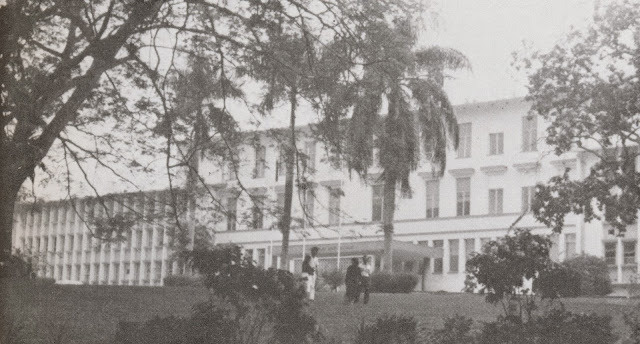
I have no idea if this is in NU or BTC.
Then in 1980, our dear government decided that hey, Singapore’s too small for 2 universities, so let’s merge NU and the University of Singapore (SU; do not ask me why it’s not US) to form… NUS! Luckily for us, SU didn’t have a CS department/faculty, so we shifted wholesale to NUS and were able to preserve our identity. 1 problem though: KENT RIDGE HAD NO SPACE FOR US! So poor us had to move to the Bukit Timah campus for a year, and then to 2 floors in 2 temporary buildings in KR (now known as MD4A).
In 1983, they decided that IS was cool and they wanted to introduce it as another major, so renamed DCS to Department of Information Systems and Computer Science (DISCS). A year later, S15 was completed, so we finally shifted in to our permanent home! Because we were growing at a crazy rate, we took over S16 in 1993 and S17 in 1998, as soon as they were built.
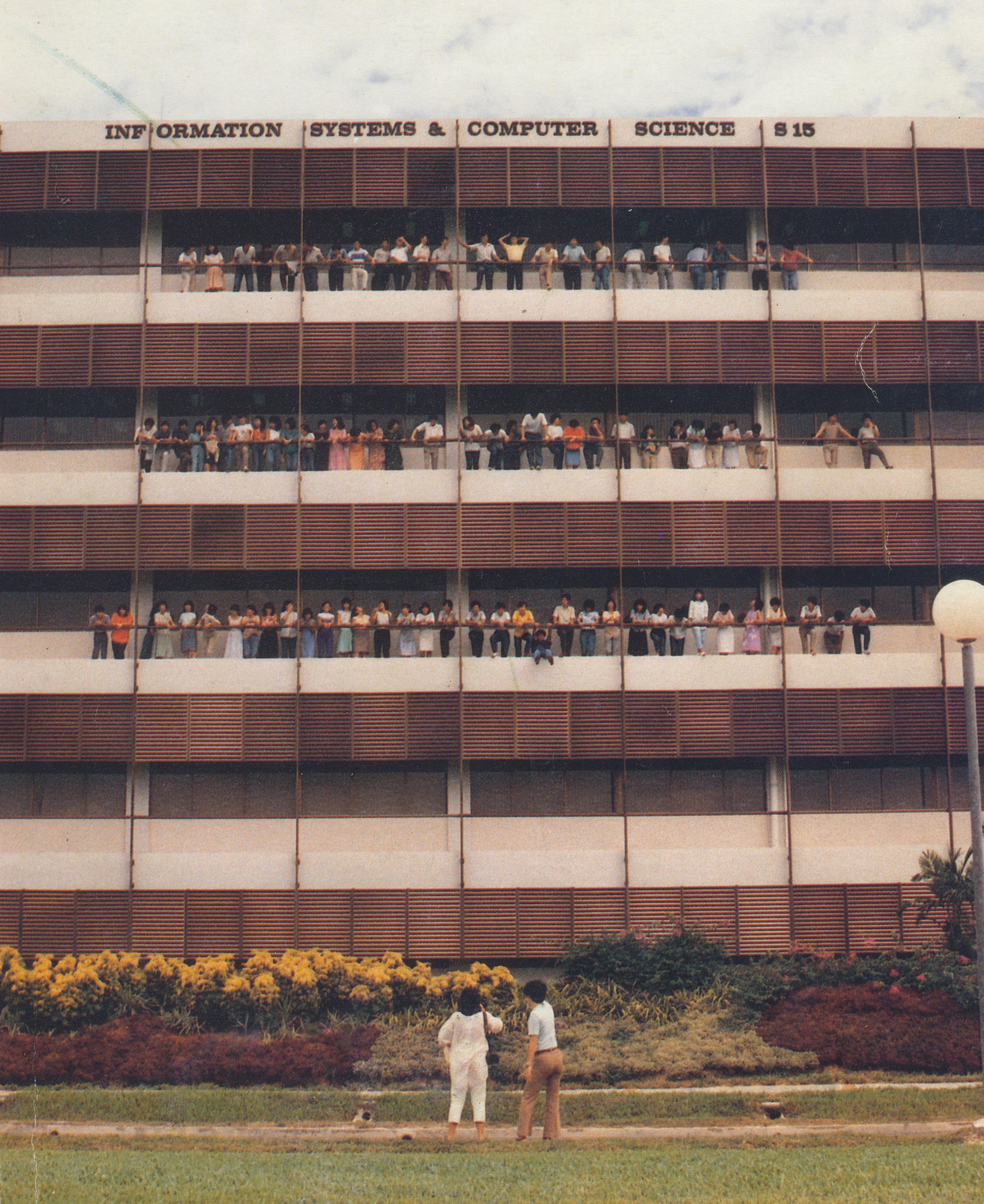
DISCS at S15.
Also in 1998, NUS decided that we were now important enough to be our own faculty. Thus, the School of Computing was born on 1st July 1998! This name was chosen over other stuff like School of Computer Science/School of Computer and Information Sciences because we wanted a "generic name that encompasses the academic and research disciplines that we want to be", according to the then acting dean, prof Chua Tat Seng. S17 was then renamed SoC1.
Fast forward to 2007, the CS department shifted to COM1, and in 2010, the department of IS shifted to COM2. Can you imagine the poor students at that time who had to travel back and forth between Science and COM1 D:
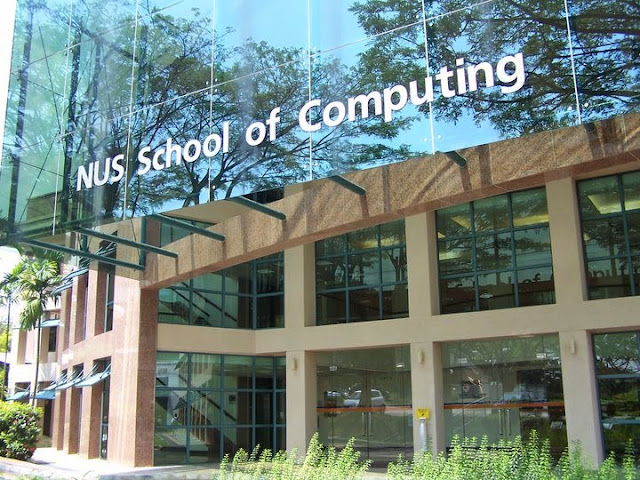
Our current building :D
And this, people, is the birth story of NUS Computing :D
10. Prof Wynne Hsu’s dad was our first department head
Some of you will probably know prof Wynne (pronounced as “Winnie”) Hsu as one of the CS1010 profs, or the data mining/retinal image analysis prof. But did you know that her dad, prof Hsu Loke Soo, was our very first department head? First, as in 1975 first.
Prof Hsu Loke Hsu
Prof Hsu Loke Soo was also the first director of the Computer Centre at NU, where they were already offering computing courses to the students. So when we were first formed in 1975, they decided that prof Hsu Loke Soo should be the department head.
In 1984, prof Hsu Loke Soo voluntarily stepped down so prof Wynne Hsu could enrol at DISCS as a student. Talk about an awesome dad, man! When I asked prof Wynne Hsu how it felt to be a student here while her dad was teaching, she said it was actually pretty cool, since she got free rides to and from campus haha (Y)
11. Programming used to be done on punch cards
For those of you who don’t know (i.e. young people like me), a punch card is a rectangular piece of card with markings on it, where programmers would punch holes in them. The presence/absence of holes in predefined positions represented commands/data for the computer. Here’s the scary part: each card represents 1 line of code. So a thousand line program is a stack of at least 1000 cards, and if you drop the tray which you kept them in (each program has its own) and mixed the order of the cards up… GLHF.
Punch cards.
Writing a program went something like this:
- Write code on paper
- Use machine to punch the cards with code
- Deposit pile of punch cards in the input tray of the Machine Room
- Wait a few hours while the operators compile and run your program
- Collect your punch cards the print out of program from the output tray
Any error in your program would be stated in the print out, and students would spend days manually debugging it. Simple stuff like missing out a letter could cause their entire program to fail due to a syntax error, which meant that they had to repeat this entire process. Oh, and did I mention that each time they sent their cards in, they had to PAY for it?!
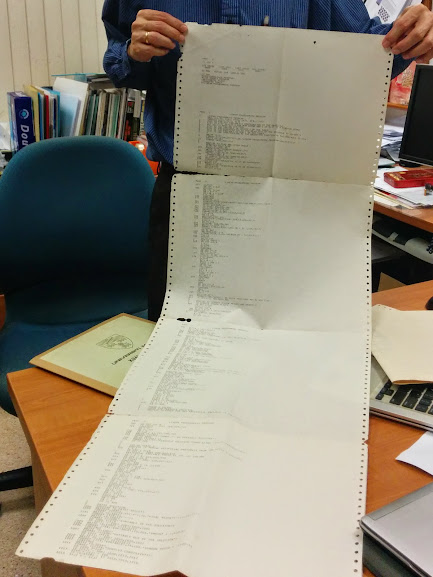
The print out of a *short* program D:
Sounds like a nightmare, right? WRONG. Apparently, the students thought it was the coolest thing ever, cause nobody else had access to computers then. Mind. Blown. Haha thankfully, we only used this terrible system till around the mid-80s.
100. Before we became a faculty, Comp Club was known as CSS
Haha I bet CSS as in Cascading Style Sheets just popped into your mind. But nope, CSS stands for the Computer Science Society, and it was set up in 1980, 5 years after we were founded (: Like their current counterpart, CSS organised many student activities, such as freshmen orientation. Strangely enough, they kept that name all throughout the DISCS period, even though we had IS students too o.o
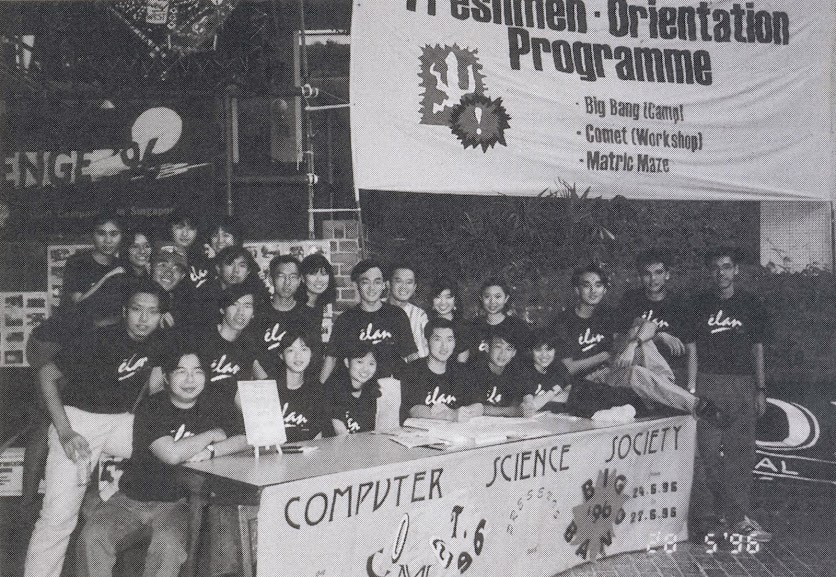 CSS, organising orientation since 1980.
CSS, organising orientation since 1980.
When we became a faculty in 1998, CSS was renamed the NUS Students’ Computing Club. As the school’s official student body, Comp Club is now a constituent member of the NUS Students’ Union (NUSSU) and has the power to do a lot more! We even have a say at various forums like the NUS Board of Undergraduate Studies :D
101. Our gender ratio used to be 50-50
Yes, you read right. The profs I spoke to all confirmed that for most of the 80s, our gender ratio was an awesome 50-50. In fact, around 83/84, there were slightly more girls than guys. Whaaaaaatttt.
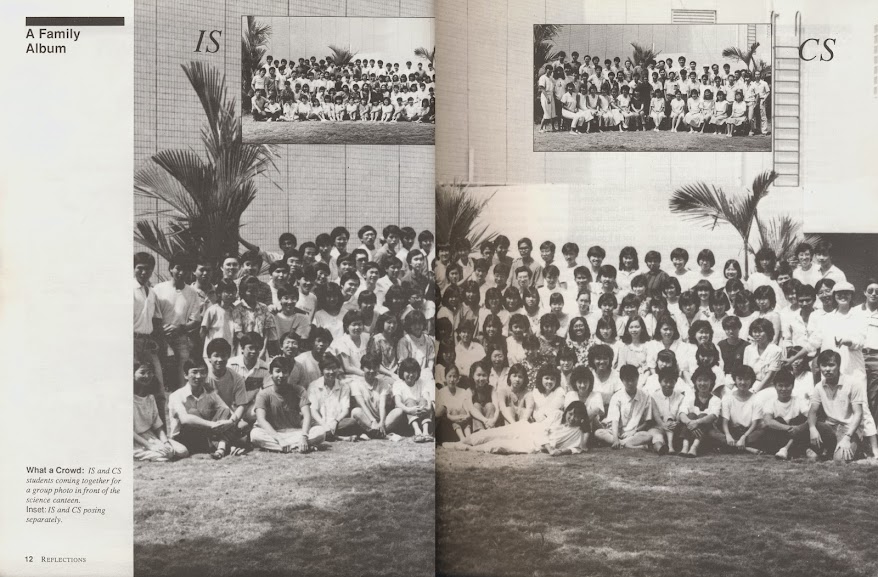 Count the number of girls.
Count the number of girls.
Naturally, my next question was, WHAT HAPPENED?!! Even though our gender ratio now is quite good at almost 2-1, it’s still a far cry from 50-50. Nobody really knows, but a few of the profs whom I spoke to said that it’s probably because parents started getting the impression that people in the IT industry work long hours, and didn’t want their daughters to do it.
Haha and oh, one of the profs had a very funny speculation. He said that Computing was so popular in the early 80s that we used to be an aptitude test, and only those who passed could enrol here. Since the guys took it after 2 years of having their brains rot away in NS, this led to more girls passing the test. HAHAHA EPIC.
110. Before Facebook and Friendster, there was BBS
Imagine a HardwareZone forum-of-sorts, but with only ASCII characters instead of a proper UI, and you get the idea of how the Bulletin Board System (BBS) looked like. At that time, we were the only faculty/department in NUS to have BBS (cause we’re cool like that!), and it lasted till around 2000. Said one of the profs I spoke to, "BBS is indeed a great highlight of those days.... it is a crazier FB if you can imagine that :D"
Similar to HWZ, BBS had multiple discussion folders where students and profs could post anything, including some pretty outrageous stuff! Each person had a BBS username, and like any forum, there were both lurkers and vocal people. Some of our profs who were very active were:
- Leong Hon Wai (“The Theorist”)
- Aaron Tan (“Garfield”)
- Colin Tan (“Polar Bear”)
- Uncle Soo or Soo Yuen Jien (“Mephistopheles”; it’s the name of a German demon!)
- Heng Cheng Suan (according to him it’s “Prince of Tides”, but according to the other profs it’s “Ocean Valentino” o.o)
I couldn't find any pictures of BBS, but prof Aaron Tan saved a few of the more interesting stories, which you can find here. Yes, everything is in Comic Sans ):
111. CAA used to be called CISAA

CISAA logo.
The Computing Alumni Association (CAA) is actually a new name which only came about in 2011. Before that, it was known as the Computer and Information Science Alumni Association (CISAA). For some reason it was only formed in 1989, even though our first batch of alumni came out in 1978 o.o
I’m not sure how true this is, but according to one of the profs, the main reason they joined CISAA in the past was because of… BBS! Haha apparently for the people who were active on BBS, it felt strange to suddenly be cut off from their friends and chat groups. Since CISAA membership cost only $10 (I think) at that time and gave them access to BBS, it was a no brainer.

CAA logo.
Oh and did you know that prof Aaron Tan was the president of CISAA from 1994-2002? That’s dedication, man!
1000. We didn’t have a modular system until 1994
Before that, almost all modules were fixed. The only choice CS students had was to choose the hardware stream (“Microcomputers”) or software stream (“Analysis of Algorithms” – its current counterpart, CS3230, is still being taught by prof Leong!). And unlike today, they only had their final exams for both sem 1 and sem 2 modules at the end of the AY! Can you imagine having a semester break in between your sem 1 modules and the final exam?! Crazy.
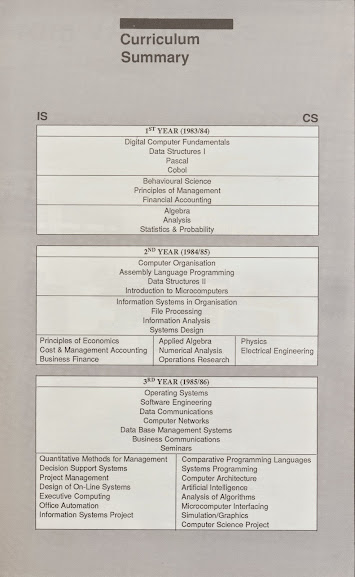
A sample of the curriculum then. IS was a lot more technical!
In 1994, we switched to the modular system (because of an NUS policy) with 6 original areas of focus. That was also the first year with programming practical exams for CS1101/2! The students had to log in to a special account without any privileges for the exam, and the funniest thing was, 1/3 of class didn't know how to even enter the editor! Hahaha apparently they only knew the shortcuts their seniors gave them :P
While this new system gives us students a lot more freedom over our education, one good thing about the old system was that students were really close to each other. It was similar to the secondary school class system, because they went through 3 years of uni with the same group. When I was looking through the old yearbooks, I was actually kinda jealous at how close everybody seemed ):
1001. We used to have graduation and freshmen orientation magazines
Speaking about yearbooks, did you know that we actually used to have yearly graduation and freshmen orientation magazines?! And that’s in addition to the yearbook! The freshmen orientation magazines were particularly interesting with all their pictures, but I guess with Facebook now, there isn't really a need for it any more, eh?
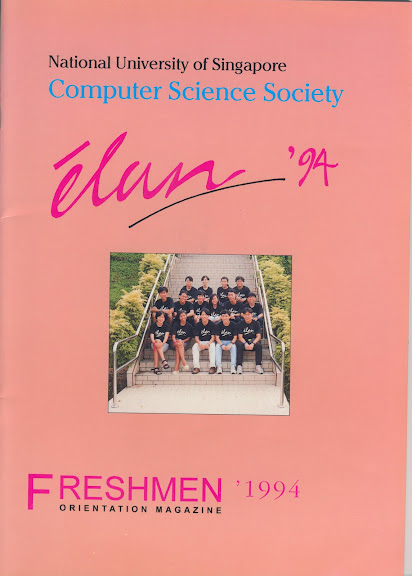
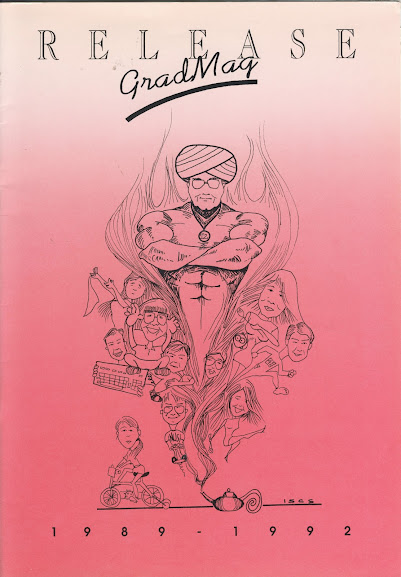 Freshmen orientation and graduation magazines.
Freshmen orientation and graduation magazines.
These magazines were one of the major sources of info for this post. It was super funny reading through the old magazines and spotting pictures of profs in their younger days :P Those who are interested can check out the magazines here.
1010. FOW comm used to be much smaller than FSC comm
 Almost the same as our current Freshmen Orientation Projects (FOP) comm.
Almost the same as our current Freshmen Orientation Projects (FOP) comm.
In fact, trawling through the freshmen orientation magazines, the earliest mention of the Freshmen Orientation Week I could find was in 1995. Back then the FOW comm had a grand total of… 3 people!!! How is that even possible?!! The Freshmen Social Camp, or rather, Orientation Camp (FOC) as it was known as before 2012, had a more reasonable number of 14 people in their comm. Both were under the Freshmen Orientation Coordinating Committee (FOCC).
Something interesting that I found out was that some of our current tried and tested orientation games date all the way back to the 80s and 90s! Like the one where you pass a polo sweet/rubber band down the line using only the toothpicks held in each person’s mouth (‘88), or that spider web game where you have to get everybody through the web without touching the strings (’94). That means some of our profs who were DISCS students went through those games too :D
Spider web and passing polo sweet games. Yup, back then we also had people gleefully watching the polo sweet game lol.
1011. Grad Night is not a new thing
For the unacquainted, Grad Night is a something like a formal dinner/prom kind of thing for the graduating students. It was introduced, or should I say, REintroduced, in 2012 with the formation of the Alumni Relations subcomm in Comp Club (my batch :D).
In the past Grad Night was called Grad Ball, and it used to be held in conjunction with the department’s annual dinner and dance. That was why we had a graduation magazine, which detailed the memories of each batch, all the way from their orientation when they were freshies. Kinda wish we still have that now!
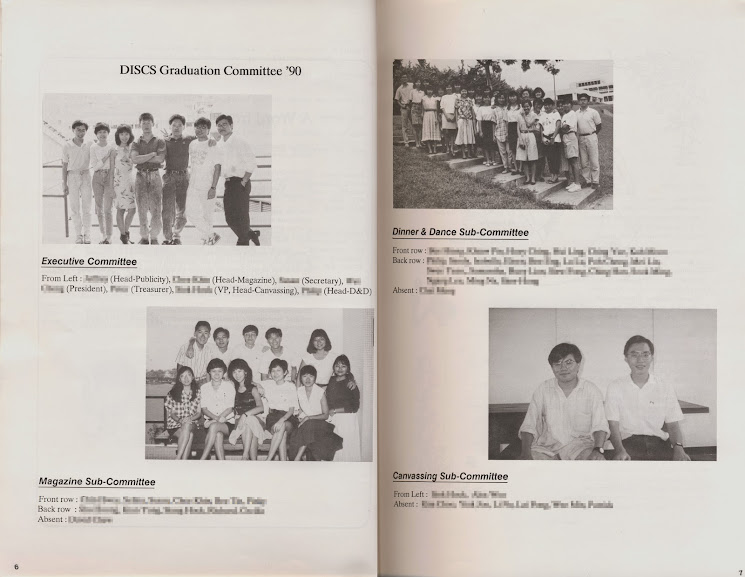
The Grad Ball comm had so many people :O
Unfortunately, with the introduction of the modular system, students weren't as close to their batch mates as they used to be, since there was no longer a fixed “class” for each person. This led to the end of Grad Ball in 2000, as students just weren't as interested as before.
1100. Our website was set up in 1995
Today, our website URL is comp.nus.edu.sg. In the past, it was www.iscs.nus.sg, and it looked... Not very nice. But ok la, websites at that time all looked like that anyway haha.

I’m so thankful that websites don’t look like this anymore hahaha :P
We were (and still are) the only ones in NUS who allowed our students to create their own homepage on the school website, though most students now don’t seem to know about it. Currently, our homepages all start with comp.nus.edu.sg/~. For example, our dean’s homepage is comp.nus.edu.sg/~david.
At the start, the school actually had to fight for this homepage thing, cause a certain ISP (guess who) saw it as us stealing their business and weren’t happy about it.
1101. Levels 1 and B1 of COM1 used to be the Law Library
Most of you probably already know that Law used to occupy COM1, but did you know that levels 1 and B1 were the Law Library? Lean over the level 1 balcony, look over the basement study area and you can almost imagine it.
When we took over the building, we had to build around the existing pillars, and that’s why the layout of that area is a bit strange. Just think of the orientation of basement programming labs. Oh and another cool thing: SR1 used to be a court room! Remember the overhanging second level area in SR1? That was the viewing gallery :O
1110. We had a joint bash with SMU SIS in 2006
Lol, wut?? I couldn’t believe my eyes too. When I saw this I was immediately reminded of the 2012 O’Week bash and how we marketed it as the first ever SoC bash. As one of the comm members for that particular camp, I kinda feel a bit guilty about not doing our research first D: sorry for misleading you guys ><
From the 2006 yearbook, the "Sin" Bash was held at Zouk, and it looks like it was really successful! The photoshoots appear to be professionally done, and they even had prizes for stage games and a $700 watch as the lucky draw prize :O Not bad.
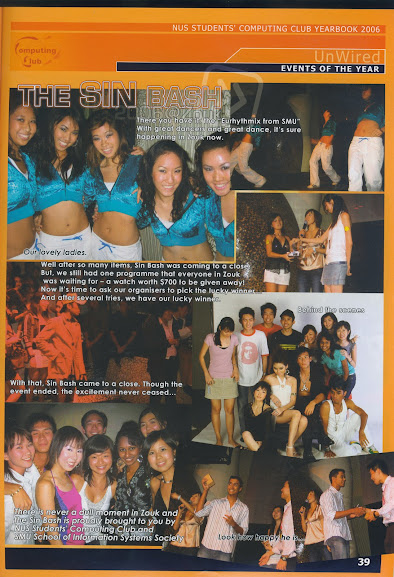
The “Sin” Bash.
I still have no idea why we held it together with SMU School of Information Systems though haha.
1111. The touchscreen directory at COM1 foyer was an FYP
This was a 2010 Final Year Project (FYP) done by the fraternal twins Kent and Torin Nguyen. For those of you who have never tried it out before, the directory shows a 3D map of Computing, which is powered by G Element’s GermaniumWeb. When you select your destination, a route through the 3D map is displayed.
In addition to the visual path are detailed walking instructions, and you can even get it to send the instructions to your mobile phone. How awesome is that! Haha apparently awesome enough that the interactive directory got featured in the Straits Times in 2011. We really have the coolest FYPs ever (:
10000. Special mention: CORS
Ok, this is not specific to Computing, but I thought I’d include it cause all of us have experienced the pain of the Centralised Online Undergraduates Registration System (CORS). But actually… CORS isn’t all that bad lol, compared to the NTU system (fastest fingers first), the SMU system (even if demand for a mod < number of vacancies, if you bid 100 “points” for it, they deduct 100 instead of 1), and the worst of all, the predecessor of CORS.
So yes, before CORS, there wasn't any centralised database; each faculty had their own database. And um. Registration for modules was done offline, by collecting profs’ signatures!! Which meant that students had to queue up outside the office of the profs who were teaching the modules they wanted. And for highly popular modules, students would often queue up overnight!! Totally reminds me of the crazy iPhone queues. Now, doesn't this make you feel so grateful to have CORS!
Haha so how many of the above 16 things did you already know before reading this? Please humour me and don't tell me you already know everything like what Yong Jie did ):< And a huge thank you to all the profs who helped me with this article; it was really nice chatting with you guys (:
Anyway! As mentioned at the start of the post, SoC is celebrating 16 years by throwing a huge gala dinner! If you're an alumni (DCS/DISCS/SoC) or current student, go sign up for it :D Oh and if you're a current student, you only have to pay a subsidised amount of only $50 (U.P. $128) for your ticket! HOW AWESOME IS THAT! Totally worth it man, so make sure you don't miss this opportunity :D Recent grads (class of '12-'14), you guys can also get a discount from CAA.
 NUS Computing Gala Dinner.
NUS Computing Gala Dinner.
Resorts World Sentosa Convention Centre
Central Ballroom
24 October, Friday, 6:30pm-11pm
Price: $128 for standard ticket, $1200 for table of 10
For current students, sign up here to get the $50 ticket. For recent grads, email president@nuscaa.sg to get the subsidised ticket. For other alumni, sign up here.
And that's all from me! See you guys at the dinner hehe I CAN'T WAIT FOR IT!! :D :D :D
-sarrie

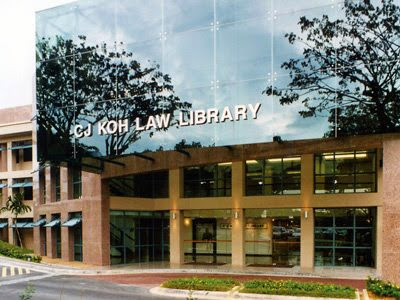
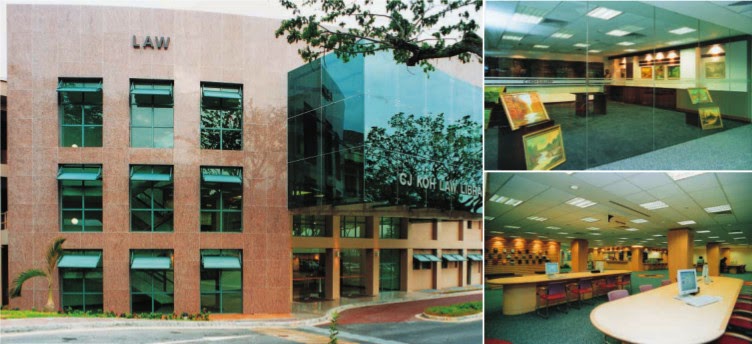
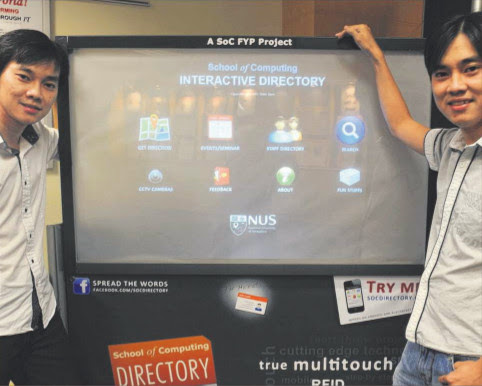
No comments:
Post a Comment